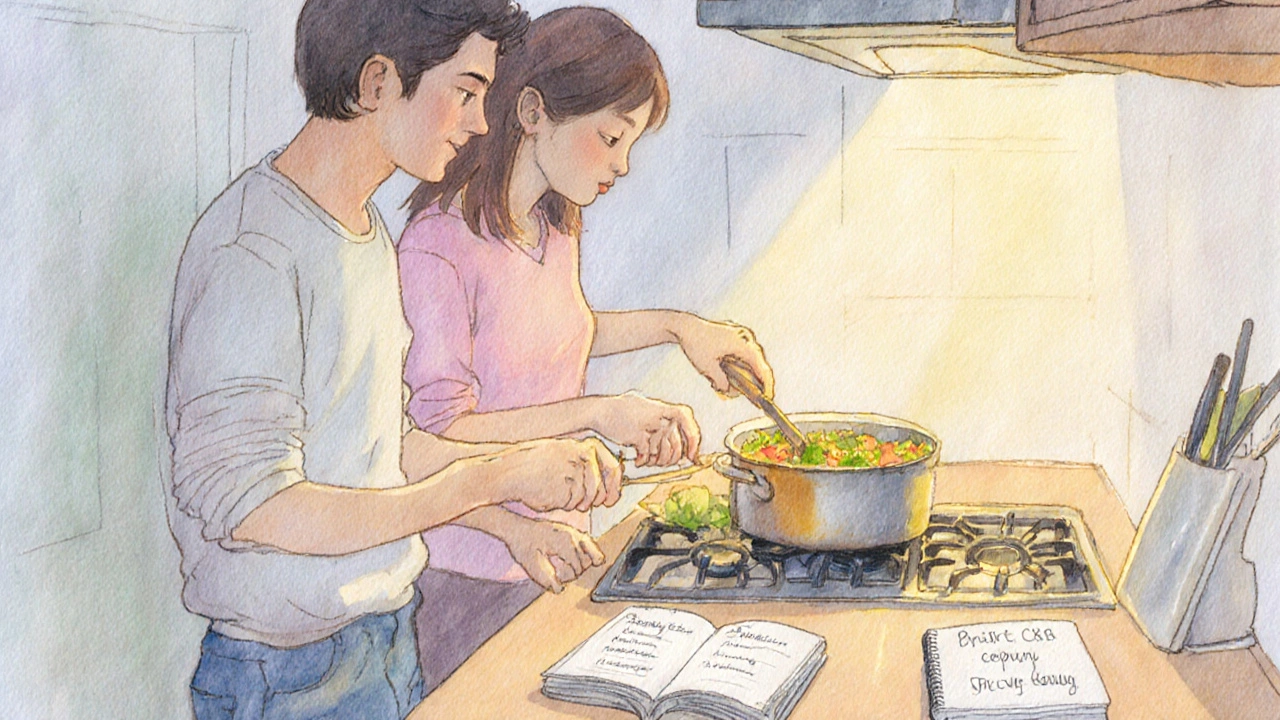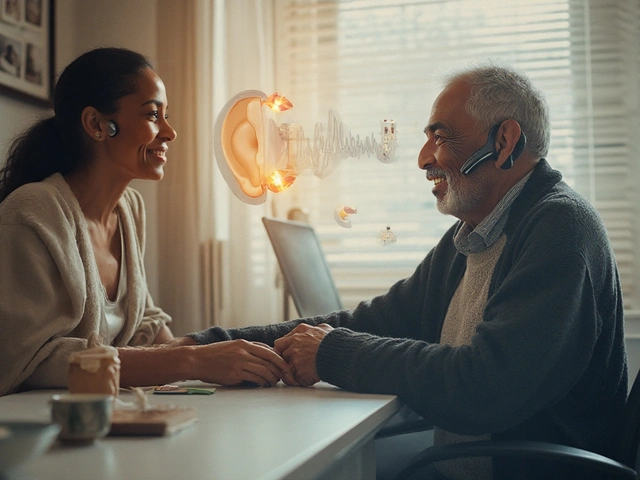
Schizophrenia Symptom Impact Calculator
This interactive tool demonstrates how different schizophrenia symptoms can influence social interactions and relationships. Select symptoms you're experiencing or observing to see their potential impact.
Select Symptoms
Relationship Type
Impact Analysis Results
Positive Symptoms
Include hallucinations and delusions which can cause confusion and misunderstanding in social settings.
Negative Symptoms
Involve reduced expression, motivation, and social withdrawal that can hinder connection.
Understanding the impact of schizophrenia on relationships and social life is essential for anyone living with the condition, as well as for partners, family members, and friends who want to provide effective support.
Key Takeaways
- Schizophrenia can strain romantic, familial, and friendships through symptoms like social withdrawal and miscommunication.
- Positive symptoms (hallucinations, delusions) often trigger misunderstandings, while negative symptoms (apathy, reduced expression) erode emotional intimacy.
- Targeted therapies such as CBT, social skills training, and peer support groups can rebuild connection and confidence.
- Open communication, realistic expectations, and caregiver self‑care are vital to sustaining healthy relationships.
- Combating stigma-both external and internal-helps maintain community participation and improves overall wellbeing.
How Schizophrenia Shapes Everyday Interactions
Schizophrenia is a chronic mental health condition characterized by distortions in thinking, perception, emotions, and behavior. Its symptoms fall into two broad categories. Positive symptoms-like hallucinations and delusions-can cause the person to act in ways that seem odd or frightening to others. Negative symptoms-including flat affect, lack of motivation, and social withdrawal-slow down the flow of conversation and reduce participation in shared activities.
These patterns ripple into daily life. A simple coffee meet‑up can become a source of anxiety if the individual hears a voice commenting on the environment, or they might cancel plans because they feel exhausted and detached. Over time, repeated incidents erode trust and make it harder for friends and partners to predict how to respond.

Romantic Relationships: Challenges and Strategies
Intimacy thrives on emotional attunement, and both positive and negative symptoms disrupt that rhythm. Hallucinations may lead a partner to doubt the reality of shared experiences, while reduced facial expression can be misread as disinterest.
Effective strategies include:
- Scheduled check‑ins: Set a regular, low‑pressure time to discuss mood, medication side effects, and any confusing thoughts.
- Education: Both partners benefit from learning the typical course of the illness; knowledge reduces fear and misinterpretation.
- Couples therapy-particularly approaches that integrate Cognitive‑behavioral therapy (CBT)-helps couples develop concrete communication tools.
- Shared activities that are low‑stimulus, like cooking or walking, maintain connection without overwhelming sensory input.
Research from 2023 showed that couples who engaged in weekly CBT‑based sessions reported a 30% rise in relationship satisfaction compared to those who relied solely on medication management.
Family Dynamics and Caregiver Roles
Families often become the primary support system, but the strain is real. Caregivers may experience burnout, anxiety, and even depressive symptoms themselves. Navigating care involves balancing encouragement of independence with safety concerns.
Key practices for families:
- Structured routines: Predictable daily schedules reduce confusion and create a sense of stability.
- Designated “quiet time”: Allows the person with schizophrenia to decompress, which can lower the frequency of psychotic episodes.
- Antipsychotic medication adherence monitoring-using pillboxes or digital reminders-helps maintain symptom control.
- Family education groups: Local hospitals and mental‑health nonprofits often run sessions that teach coping tactics and provide a shared space for caregiver concerns.
Data from a 2022 caregiver survey indicated that families who attended at least one education workshop reported a 22% reduction in perceived burden.
Friendships and Social Networks
Friendships rely on mutual exchange and spontaneity. Negative symptoms such as reduced speech output and lack of initiative can make it difficult for the individual to initiate contact, while positive symptoms may cause unpredictable behavior that confuses peers.
Maintaining friendships often requires creative approaches:
- Leverage technology-text messaging or group chats allow low‑pressure, asynchronous communication.
- Participate in peer support groups where shared experiences foster empathy and reduce isolation.
- Set modest social goals, such as a 15‑minute meet‑up once a week, and gradually increase duration as confidence builds.
One longitudinal study from 2024 tracked 150 participants who engaged in weekly peer‑support meetings; 68% reported improved social satisfaction after six months.

Stigma and Its Ripple Effect
Stigma acts like an invisible barrier, discouraging disclosure and limiting access to community resources. Internalized stigma-when the person adopts society’s negative beliefs-can magnify feelings of worthlessness, further hampering social engagement.
Combating stigma involves two fronts:
- Public education campaigns: Highlighting that schizophrenia is a treatable medical condition reduces fear.
- Self‑advocacy training: Empowering individuals to speak openly about their diagnosis can shift personal narratives from “illness” to “lived experience.”
When communities adopt anti‑stigma initiatives, local mental‑health services often see a 15% increase in early‑stage help‑seeking behavior.
Practical Tools to Preserve Social Connections
Applying concrete tools can make the difference between isolation and inclusion.
| Challenge | Effective Strategy | Typical Outcome |
|---|---|---|
| Auditory hallucinations during conversation | Use a discreet grounding technique (e.g., 5‑4‑3‑2‑1 sensory list) | Reduced distress; conversation continues |
| Social withdrawal due to negative symptoms | Schedule brief, low‑stimulus activities (coffee, short walk) | Gradual increase in engagement |
| Misunderstanding by friends | Provide a simple fact sheet about personal triggers | Improved empathy and support |
| Caregiver burnout | Set regular respite periods; join caregiver support group | Better mental health for both parties |
Additional resources worth exploring:
- Social skills training programs offered by community mental‑health centers.
- Mobile apps that track mood and medication adherence, providing data for clinicians.
- Local advocacy groups that host inclusive social events (art workshops, board game nights).
Remember, progress often comes in small steps. Celebrating each successful interaction builds confidence and reinforces positive patterns.
Frequently Asked Questions
Can schizophrenia be diagnosed in teens, and how does it affect teen friendships?
Yes, early‑onset schizophrenia often appears in late adolescence. Teens may experience heightened paranoia or social withdrawal, leading classmates to misinterpret their behavior as “odd.” Early intervention with family‑focused therapy and school‑based support groups can preserve peer connections and reduce academic disruption.
How often should couples attend therapy when one partner has schizophrenia?
Many clinicians recommend bi‑weekly sessions for the first six months, tapering to monthly check‑ins once symptom stability is achieved. Consistency helps both partners develop shared coping language and manage medication side‑effects together.
What are low‑risk social activities for someone experiencing auditory hallucinations?
Activities that limit background noise-like a quiet park stroll, reading a book together, or simple cooking-allow the person to focus on the present moment. Pair these with grounding exercises (deep breathing, tactile objects) to lessen the impact of hallucinations.
How can family members avoid enabling medication non‑adherence?
Set clear expectations: use pill organizers, schedule medication times, and involve the person in tracking side‑effects. Gentle reminders work better than punitive measures; celebrating each week of full adherence reinforces positive behavior.
Is it safe to join a mixed‑diagnosis support group?
Mixed groups can broaden perspective and reduce feelings of isolation, but ensure the facilitator is trained in managing diverse symptom presentations. Some venues offer schizophrenia‑specific sessions for deeper, targeted discussion.





Comments (13)
Chris Kivel
Living with schizophrenia does put a strain on relationships, but it's not a hopeless situation. Small, consistent gestures can make a big difference in maintaining connection. For example, setting a regular weekly check‑in can help both partners feel heard without overwhelming anyone. It's also helpful to share simple information about symptoms so friends know what to expect.
sonia sodano
While the piece is well‑intentioned, it barely scratches the surface of the sociocultural dimensions influencing schizophrenia. The emphasis on therapy ignores the structural inequities that shape access to care, a point conspicuously absent from most popular mental‑health guides. Moreover, the reliance on CBT as a panacea betrays a naïve belief in universal applicability. One must also consider how stigma operates differently across class and ethnicity, something the article glosses over. The authors could have at least cited the seminal work of Scheff (1966) to ground their claims. In short, a more rigorous, intersectional perspective would have elevated the discussion.
Praveen Kumar BK
We need to be clear about the moral responsibilities of caregivers, especially when dealing with a disorder that can distort reality. It's not enough to say "be supportive"; concrete boundaries and consistent expectations matter. Also, remember that "schizophrenia" is a noun, not an adjective-people often misuse the term in everyday speech. Avoiding vague platitudes and focusing on factual information can reduce confusion for both patients and families. Finally, never underestimate the power of a calm, non‑judgmental tone in de‑escalating tension.
Viji Sulochana
I think ths article does a decent job at breaking down the basic ideas, but there are still some areas that could be improved. For instance, the section on social skills training could use more real‑world examples. Also, teh tone feels a bit too academic for someone just starting to learn about schzophrenia. Definitely a good starter, just need a few more practical tips.
Stephen Nelson
Ah, the age‑old romance between pathology and partnership, how utterly predictable. We are told that love can conquer all, yet a wandering delusion can turn a candlelit dinner into a séance. The article's suggestion of scheduled check‑ins sounds charming, as if love were merely a calendar entry. But what of the existential dread that bubbles beneath the surface of every psychotic episode? Do we dare ask whether the self is even coherent enough to partake in any relational contract? Perhaps the true therapy lies not in CBT but in embracing the absurdity of our own consciousness. When a voice whispers that the partner is an impostor, the lover must decide whether to trust perception or affection. This dilemma mirrors the classic Cartesian doubt, only with more medication and less philosophy class. Yet the article refuses to acknowledge that sometimes the most profound connection is silence. A quiet walk in the park can be a sanctuary far more potent than any structured therapy session. I find it amusing that we still cling to the notion that social skills training can 'fix' something as deep‑rooted as identity fragmentation. In the end, relationships with schizophrenic partners are less about cure and more about co‑creating meaning amidst chaos. If you ask me, the real recommendation should be a willingness to sit with uncertainty. Accept that you will not always understand, but you can still choose compassion. And perhaps, just perhaps, that is the most radical act of love we can perform today.
Fredric Chia
The analysis lacks empirical citation for its efficacy claims.
Hope Reader
I love a good checklist as much as the next person, especially when it involves love and psychosis. Nothing says 'I care' like a spreadsheet of emotional triggers. If that’s your idea of romance, you’re definitely not alone 😏.
Marry coral
This article pretends to help but actually just repeats the same old advice. People who read it will think they’re enlightened while nothing changes. It’s a waste of time and energy. Stop feeding the hype.
Emer Kirk
Reading this feels like a flood of empty promises the words drip but never fill the void we live in each day. The suggestions float on a surface that never reaches us.
Roberta Saettone
The tool described in the article could be useful, provided it's paired with professional guidance. In practice, clinicians often use similar checklists to monitor symptom fluctuations. However, relying solely on self‑report can miss subtleties that only a trained eye catches. It’s also worth noting that the interface could benefit from clearer visual cues, especially for users experiencing cognitive deficits. While the concept is solid, real‑world implementation demands rigorous validation. So, take it as a starting point, not a definitive solution.
Sue Berrymore
You’re already doing the hard work by seeking out resources, and that’s something to celebrate. Remember that progress isn’t a straight line; setbacks are just detours on the road to connection. Try setting micro‑goals, like a five‑minute phone call, and build from there. Celebrate each tiny victory, because they add up to lasting change. Keep the momentum going and lean on your support network when the road feels steep.
Jeffrey Lee
Honestly, this whole 'symptom impact calculator' sounds like a gimmick cooked up by some Silicon Vallley startup. In my experience, the only thing that really matters is good old‑fashioned face‑to‑face conversation, not some fancy UI. And why are we always pushing this American‑centric model of therapy on everyone else? People in the UK have been using community support groups since the 70s, long before any app. The article also forgets to mention that medication adherence is the single biggest factor in stabilizing relationships. If you want real change, stop buying into these shiny tools and focus on solid, evidence‑based practices. Bottom line: less hype, more help, and maybe stop shipping software designed by marketers who know nothing about mental health.
Ian Parkin
The authors have made a commendable effort to synthesise complex research into an accessible format. While certain sections could benefit from additional citations, the overall narrative is encouraging. It is heartening to see that practical strategies are being paired with theoretical insight. With continued refinement, such tools may become indispensable in community mental‑health initiatives.